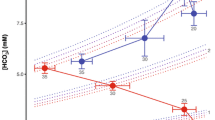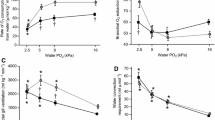Abstract
The aim of the present study was to determine the roles of externally versus internally oriented CO2/H+-sensitive chemoreceptors in promoting cardiorespiratory responses to environmental hypercarbia in the facultative air-breathing fish, Chitala ornata (the clown knifefish). Fish were exposed to environmental acidosis (pH ~ 6.0) or hypercarbia (≈ 30 torr PCO2) that produced changes in water pH equal to the pH levels of the acidotic water to distinguish the relative roles of CO2 versus H+. We also injected acetazolamide to elevate arterial levels of PCO2 and [H+] in fish in normocarbic water to distinguish between internal and external stimuli. We measured changes in gill ventilation frequency, air breathing frequency, heart rate and arterial blood pressure in response to each treatment as well as the changes produced in arterial PCO2 and pH. Exposure to normocarbic water of pH 6.0 for 1 h did not produce significant changes in any measured variable. Exposure to hypercarbic water dramatically increased air breathing frequency, but had no effect on gill ventilation. Hypercarbia also produced a modest bradycardia and fall in arterial blood pressure. Injection of acetazolamide produced similar effects. Both hypercarbia and acetazolamide led to increases in arterial PCO2 and falls in arterial pH although the changes in arterial PCO2/pH were more modest following acetazolamide injection as were the increases in air breathing frequency. The acetazolamide results suggest that the stimulation of air breathing was due, at least in part, to stimulation of internally oriented CO2/H+ chemoreceptors monitoring blood gas changes.





Similar content being viewed by others
References
Aota S, Holmgren KD, Gallaugher P, Randall DJ (1990) A possible role for catecholamines in the ventilatory responses associated with internal acidosis or external hypoxia in rainbow trout. J Exp Biol 151:57–70
Babiker MM (1979) Respiratory behaviour, oxygen consumption and relative dependence on aerial respiration in the African lungfish (Protopterus anectens, Owen) and an air breathing teleost (Clarius lazera, C.). Hydrobiologia 65:177–187
Belão TC, Zeraik VM, Florindo LH, Kalinin AL, Leite CAC, Rantin FT (2011) Control of cardiorespiratory function in response to hypoxia in an air-breathing fish, the African catfish, Clarias gariepinus. Comp Biochem Physiol A 187:130–140
Belão TC, Leite CAC, Florindo LH, Kalinin AL, Rantin FT (2015) Cardiorespiratory responses to hypoxia in the African catfish, Clarias gariepinus (Burchell 1822), an air-breathing fish. J Comp Physiol B 181:905–916
Corcoran AE, Wilson RJA, Harris MB (2007) Central CO2/pH chemosensitivity in a modern air-breathing teleost; evidence in vitro and in vivo. Soc Neurosci Abstr 297:11
Damsgaard C, Gam LTH, Tuong DD, Thinh PV, Huong DTT, Wang T, Bayley M (2015) High capacity for extracellular acid–base regulation in the air-brething fish Pangasianodon hypophthalmus. J Exp Biol 218:1290–1294
de Lima Bojink CL, Florindo LH, Leite CAC, Kalinin AL, Milsom WK, Rantin FT (2010) Hypercarbic cardiorespiratory reflexes in the facultative air-breathing fish jeju (Hoplerythrinus unitaeniatus): role of branchial CO2 chemoreceptors. J Exp Biol 213:2792–2807
Dehadrai PV (1962) Respiratory function of the swimbladder of Notopteru (Lacépède). Paper presented at the Proceedings of the Zoological Society of London
Delaney RG, Lahiri S, Fishman AP (1974) Aestivation of the African lungfish Protopterus aethiopicus: cardiovascular and respiratory functions. J Exp Biol 61:111–128
Delaney RG, Shub C, Fishman AP (1976) Haematologic observations on the aquatic and aestivating African lungfish Protopterus aethiopicus. Copeia 1976:423–434
Delaney RG, Lahiri S, Hamilton R, Fishman AP (1977) Acid–base balance and plasma composition in the aestivating lungfish (Protopterus). Am J Physiol 232:R10–R17
Gilmour KM (2001) The CO2/pH ventilatory drive in fish. Comp Biochem Physiol A 130:219–240
Gilmour KM, Milsom WK, Rantin FT, Reid SG, Perry SF (2005) Cardiorespiratory responses to hypercarbia in tambaqui Colossoma macropomum: chemoreceptor orientation and specificity. J Exp Biol 208(6):1095–1107
Graham JB (1997) Air-breathing fishes: evolution, diversity, and adaptation. Academic Press, San Diego
Graham JB, Baird TA (1982) The transition to air breathing in fishes: I. environmental effects on the facultative air breathing of Ancistrus chagresi and Hypostomus plecostomus (Loricariidae). J Exp Biol 96:53–67
Graham MS, Turner JD, Wood CM (1990) Control of ventilation in the hypercapnic skate, Raja ocellata. I. Blood and extradural fluid chemistry. Respir Physiol 80:259–277
Harter TS, Shartau RB, Brauner CJ and Farrell AP (2014) Validation of the i-STAT system for the analysis of blood parameters in fish. Conserv Physiol 2. https://doi.org/10.1093/conphys/cou037
Hedrick MS, Burleson ML, Jones DR, Milsom WK (1991) An examination of central chemosensitivity in an air-breathing fish (Amia calva). J Exp Biol 155:165–174
Heisler N, Toews DP, Holeton GF (1988) Regulation of ventilation and acid–base status in the elasmobranch Scyliorhinus stellaris during hyperoxia induced hypercapnia. Respir Physiol 71:227–246
Hoffman M, Harris MB, Taylor BE (2009) Characterization and validation of aerial respiration and central CO2 chemosensitivity in the Alaska blackfish, Dallia pectoralis. FASEB J 23:598.16
Iversen NK, Huong DTT, Bayley M, Wang T (2011) Autonomic control of the heart in the Asian swamp eel (Monopterus albus). Comp Biochem Physiol 158A:485–489
Janssen RG, Randall DJ (1975) The effects of changes in pH and PCO2 in bood and water on breathing in rainbow trout, Salmo gairdneri. Respir Physiol 25:235–245
Jesse MJ, Shub C, Fishman AP (1967) Lung and gill ventilation of the African lungfish. Respir Physiol 3:267–287
Johansen K (1966) Air breathing in the teleost Symbranchus marmoratus. Comp Biochem Physiol 18:383–395
Johansen K, Lenfant C (1968) Respiration in the African lungfish, Protopterus aethiopicus. II. Control of breathing. J Exp Biol 49:453–468
Johansen K, Lenfant C, Grigg GC (1967) Respiratory control in the lungfish, Neoceratodus fosteri (Krefft). Comp Biochem Physiol 20:835–854
Johansen K, Hanson D, Lenfant C (1970) Respiration in a primitive air breather, Amia calva. Respir Physiol 9:162–174
Jonz MG, Zachar PC, Da Fonte DF, Mierzwa AS (2015) Peripheral chemoreceptiors in fish: a brief history and a look ahead. Comp Biochem Physiol A 186:27–38
Li S, Lu X, Bush RT (2013) CO2 partial pressure and CO2 emission in the Lower Mekong River. J Hydrology 504:40–56
Lomholt JP, Johansen K (1974) Control of breathing in Amphipnous cuchia, an amphibious fish. Respir Physiol 21:325–340
Lopes JM, Boijink CL, Florindo LH, Leite CAC, Kalinin AL, Milsom WK, Rantin FT (2010) Hypoxic cardiorespiratory reflexes in the facultative air-breathing fish jeju (Hoplerythrinus unitaeniatus): role of branchial O2 chemoreceptors. J Comp Physiol 180B:797–811
Malte CL, Jakobsen SL, Wang T (2014) A critical evaluation of automated blood gas measurements in comparative respiratory physiology. Comp Biochem Physiol A Mol Integr Physiol 178:7–17
McKendry JE, Perry SF (2001) Cardiovascular effects of hypercapnia in rainbow trout (Oncorhynchus mykiss): a role for externally oriented chemoreceptors. J Exp Biol 204:115–125
McKenzie DJ, Campbell HA, Taylor EW, Micheli M, Rantin FT, Abe AS (2007) The autonomic control and functional significance of the changes in heart rate associated with air breathing in the jeju, Hoplerythrinus unitaeniatus. J Exp Biol 210:4224–4232
McMahon BR, Burggren WW (1987) Respiratory physiology of intestinal air breathing in the teleost fish Misgurnus anguillicaudatus. J Exp Biol 133:371–393
Milsom WK (2012) New insights into gill chemoreception: receptor distribution and roles in water and air breathing fish. Respir Physiol Neurobiol 184(3):326–339
Perry SF, Gilmour KM (2002) Sensing and transfer of respiratory gases at the fish gill. J Exptl Zool 293:249–263
Perry SF, McKendry JE (2001) The relative roles of external and internal CO2 versus H+ in eliciting the cardiorespiratory responses of Salmo salar and Squalus acanthias to hypercarbia. J Exp Biol 204:3963–3971
Poulsen AF, Hortle K, Valbo-Jorgensen J, Chan S, Chhuon C, Viravong S, Nguyen T (2004) Distribution and ecology of some important riverine fish species of the Mekong River Basin. MRC Tech Paper 10:116
Reid SG, Sundin L, Kalinin AL, Rantin FT, Milsom WK (2000) Cardiovascular and respiratory reflexes in the tropical fish, traíra (Hoplias malabaricus): CO2/pH chemoresponses. Respir Physiol 120:47–59
Sanchez AP, Glass ML (2001) Effects of environmental hypercapnia on pulmonary ventilation of the South American lungfish. J Fish Biol 58:1181–1189
Sanchez AP, Hoffmann A, Rantin FT, Glass ML (2001) Relationship between cerebro-spinal fluid pH and pulmonary ventilation of the South American lungfish, Lepidosiren paradoxa (Fitz.). J Exp Zool 290:421–425
Sanchez AP, Giusti H, Bassi M, Glass ML (2005) Acid–base regulation in the South American lungfish Lepidosiren paradoxa: Effects of prolonged hypercarbia on blood gases and pulmonary ventilation. Physiol Biochem Zool 78:908–915
Simard E, Trepanier G, Larochelle J, Kinkead R (2003) Intermittent hypoxia and plasticity of respiratory chemoreflexes in metamorphic bullfrog tadpoles. Respir Physiol Neurobiol 135:59–72
Smatresk NJ (1988) Control of the respiratory mode in air-breathing fishes. Can J Zool 66:144–151
Smatresk NJ, Cameron JN (1982) Respiration and acid–base physiology of the spotted gar, a bimodal breather. II. Responses to temperature change and hypercapnia. J Exp Biol 96:1253 281–293
Smith HW (1930) Metabolism of the lungfish Protopterus aethiopicus. J Biol Chem 88:97–130
Soivio A, Nynolm K, Westman K (1975) A technique for repeated sampling of the blood of individual resting fish. J Exp Biol 63(1):207–217
Sundin L, Reid SG, Rantin FT, Milsom WK (2000) Branchial receptors and cardiorespiratory reflexes in a neotropical fish, the tambaqui (Colossoma macropomum). J Exp Biol 203(7):1225–1239
Taylor EW, Leite CAC, Sartori MR, Wang T, Abe AS, Crossley DA (2014) The phylogeny and ontogeny of autonomic control of the heart and cardiorespiratory interactions in vertebrates. J Exp Biol 217:690–703
Teixeira MT, Armelin VA, Abe AS, Rantin FT, Florindo LH (2015) Autonomic control of post-air-breathing tachycardia in Clarias gariepinus (Teleostei: Clariidae). J Comp Physiol B 185:669–676
Thomsen M, Wang T, Milsom W, Bayley M (2017) Lactate provides a strong pH independent ventilatory signal in the facultative air-breathing teleost Pangasianodon hypopthalmus. Sci Rep 7:6378
Tuong DD, Ngoc TB, Huynh VTN, Huong DTT, Phuong NT, Hai TN, Wang T, Bayley M (2018) Clown knifefish (Chitala ornata) oxygen uptake and its partitioning in present and future temperature environments. Comp Biochem Physiol A Mol Integr Physiol. 216:52–59
Ultsch GR (1987) The potential role of hypercarbia in the transition from water-breathing to air-breathing in vertebrates. Evolution 41:442–445
Vidthayanon C (2012) Chitala ornata. IUCN Red List Threat Species. https://doi.org/10.2305/IUCN.UK.2012-1.RLTS.T181056A1693604.en
Viet TV (2015) Applications of GIS for evaluation the current culture status of Clown knife fish (Chitala ornata) in Phung Hiep District, Hau Giang Province. J Can Tho Univ 38:109–115
Wilson RJA, Harris MB, Remmers JE, Perry SF (2000) Evolution of air-breathing and central CO2/H+ respiratory chemosensitivity: new insights from an old fish? J Exp Biol 203:3505–3512
Wood CM, Munger RS (1994) Carbonic anhydrase injection provides evidence for the role of blood acid–base status in stimulating ventilation after exhaustive exercise in rainbow trout. J Exp Biol 194:225–253
Wood CM, Turner JD, Munger RS, Graham MS (1990) Control of ventilation in the hypercapnic skate Raja ocellata: II. Cerebrospinal fluid and intracellular pH in the brain and other tissues. Respir Physiol 80:279–298
Acknowledgements
This research was funded by the Danish Ministry of Foreign Affairs: Danida fellowship Centre Project 272 number: DFC 12-014AU iAQUA, The Danish International Development Agency (DANIDA) and by the Natural Sciences and Engineering Research Council of Canada.
Author information
Authors and Affiliations
Corresponding author
Additional information
Communicated by G. Heldmaier.
Rights and permissions
About this article
Cite this article
Tuong, D.D., Borowiec, B., Clifford, A.M. et al. Ventilatory responses of the clown knifefish, Chitala ornata, to hypercarbia and hypercapnia. J Comp Physiol B 188, 581–589 (2018). https://doi.org/10.1007/s00360-018-1150-9
Received:
Revised:
Accepted:
Published:
Issue Date:
DOI: https://doi.org/10.1007/s00360-018-1150-9




